Cooler Master Hyper 212 Plus, Cooler Master Hyper N620 and Cogage TRUE Spirit CPU Coolers

Today we are going to talk about three new air coolers for central processors. In fact, these solutions offer noting principally revolutionary, but each boasts its own unique features.
Three new CPU coolers that we are going to discuss today are very similar to one another because they all use tower heatsink design of similar structure, fans of the same size and type and boast a few other similar parameters. As for the major aspects, such as cooling efficiency, noise level, compatibility and price point, the new Cooler Master solutions and Cogage cooler differ dramatically. And while our regular readers are very well familiar with the first brand, the second one – Cogage – is a new name in this market. However, we can really call it a new name with a proviso, because Cogage is a daughter brand of the well-known Thermalright Company, which solutions are targeted for the budget market segment. “Thermalright for the masses” – this could be the slogan for Cogage products promotion. Remember, ASRock brand by ASUSTeK or TR brand by Thermltake. Well, let’s see how well one of the leaders in the cooling solutions market copes with this task.
Please meet Cooler Master Hyper 212 Plus, Cooler Master Hyper N620 and Cogage TRUE Spirit coolers.
Package and Accessories
Unlike our previous cooler reviews, we decided not to single out each cooler into an individual review section, but to compare them all the way side by side. I believe that this approach is more convenient for adequate comparison of cooling solutions with design of the same type and similar set of features, because it allows to find the distinguishing peculiarities of each cooler more easily. Hereinafter the coolers will be always lined up in the same order as they were listed above: Cooler Master Hyper 212 Plus, Cooler Master Hyper N620 and Cogage TRUE Spirit.
The boxes of all coolers are made if thick cardboard. Cooler Master packaging is designed in the company’s traditional manner: purple-and-white colors with the cooler picture on the front of the box and the list of its technical specifications on the back. Cogage TRUE Spirit box has a window cut out in the front, which reveals almost the entire cooler heatsink:
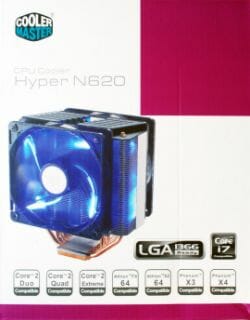
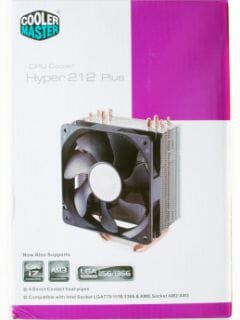
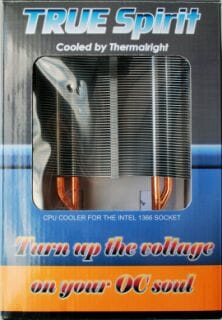
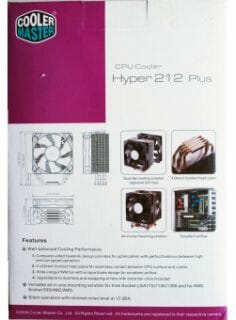
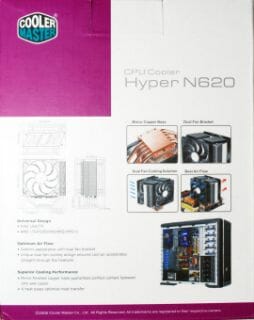
Inside the cardboard package of the Cooler Master solutions there is a plastic blister molded to match the cooler shape and size exactly and protecting the cooler from any physical damages. Cogage cooler sits securely in a cardboard stand that also protects it very well during transportation.
The coolers are bundled with a full set of accessories necessary for cooler use with all contemporary platforms:
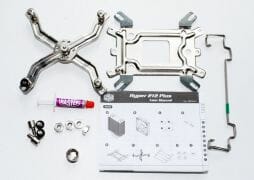
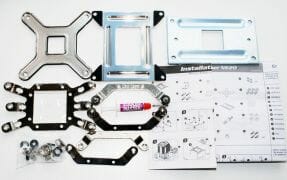
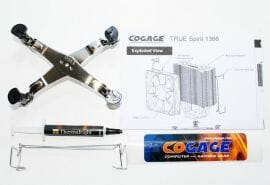
The sets are pretty typical, we discovered no unique components among the bundled items that is why we will not list all of them here again. All coolers are made in China. The recommended price for Cooler Master Hyper 212 Plus is $29.99, Hyper N620 – $59.90, and Cogage TRUE Spirit – $39.85.
Design and Functionality
Cooler Master Hyper 212 Plus and Cogage TRUE Spirit heatsinks are packed separately, without the fans that is why I decided to both fans off the Cooler Master Hyper N620, too. So, we are going to compare the heatsinks first.
The actual heatsink dimensions are: Hyper 212 Plus – 116x51x112 mm; Hyper N620 – 141x51x108 mm; TRUE Spirit – 132x53x103 mm. I am sure that the last heatsink reminded you of the Thermalright Ultra-120 eXtreme. It is practically the case, because TRUE Spirit is almost an exact copy of the Thermalright Ultra-120 heatsink, but without nickel-plating and with slightly thicker heatsink plates.
The aluminum plates of all heatsinks are of the same thickness and measure 0.45-0.50 mm with a 2.0 mm gap between them. However, each heatsink has its own number of plates in the array: 57, 62 and 48 respectively.
The sides of Hyper 212 Plus cooler are not covered in any way. The side of Hyper N620 heatsink is partially covered, while the TRUE Spirit heatsink has the central part of the plates linked together.
Hyper 212 Plus and TRUE Spirit have four copper heatpipes each, 6 mm in diameter, while Hyper N620 has six of them, although you may think there are only five if you look at the cooler from the top.
In reality there are six heatpipes, however, two of them only pierce the heatsink array on one side that is why you get the impression that there are five of them instead of six.
Another peculiarity typical of all three coolers discussed today is the nonlinear positioning of the heatpipes in the heatsink array, which allows to distribute the heat over the aluminum plates more evenly.
Each cooler has its own unique base. Cooler Master Hyper 212 Plus uses Direct Contact technology with a 3 mm (!) gap between the heatpipes in the base. Our experience with cooling solutions using Direct Contact technology indicates that the distance between the heatpipes in the base of the cooler is critical for maximum cooling efficiency. The smaller this gap is, the better. However, Hyper 212 Plus has an extremely large distance between the heatpipes.
Hyper N620, in its turn, has a classical copper base plate. The heatpipes lie in special grooves and the contact surfaces are all soldered together. The base of TRUE Spirit cooler is built according to the same exact principle, but it is also nickel-plated.
Unfortunately, TRUE Spirit inherited not only the shape of the Thermalright Ultra-120 heatsink, but also a bent base plate surface.
Surprisingly, Hyper N620 also has a small bump in the center of the plate, though it is not so prominent as by TRUE Spirit.Of course, these defects did affect the quality of the thermal imprint left by the evened out and polished processor heat-spreader on the cooler bases.
Cooler Master Hyper 212 Plus has a very even base, but unfortunately, the thermal compound imprint on the CPU surface turned out “striped” with gaps from the aluminum inserts between the heatpipes.
Of course, in this case we can’t claim that there will be any even heat flow exchange between the CPU and the cooler.All three cooling solutions discussed today are equipped with 120x120x25 mm fans. The fan shape and structure is completely different in each case.
Hyper 212 Plus is equipped with a black matt fan with seven blades of very sophisticated shape. Their exterior edge is so bent that it looks like the blades are “floating” over the heatsink surface instead of sending the airflow straight through it. Hyper N620 has glossy fan frame and blades that is why these fans looks very pretty. Eleven semitransparent crescent-shaped blades are very aggressively curved. The fan installed on TRUE Spirit cooler is somewhat similar to Noiseblocker NB-BlackSilent fans, but the blades are of different color here.
The fan rotation speed of the fans on all three coolers is PWM controlled. The rotation speed of the fan on Hyper 212 Plus can vary in the interval from 600 to 2000 RPM, on Hyper N620 – from 800 to 2000 RPM, and on TRUE Spirit – from 1000 to 1500 RPM. The claimed noise levels for all three are 13-32 dBA, 16-28.8 dBA and 19.6-37.4 dBA respectively. You can check the spec table below for other fan specifications, and now let’s take a look at the stickers on the fan rotors.
The interesting thing is that the sticker on the TRUE Spirit fan rotor states a different rotation speed interval than the cooler specifications (1000-1800 RPM vs. 1000-1500 RPM), and according to the monitoring data, the fan was working at 1030-1650 RPM. Here I have to add that the fans used on Cooler Master solutions are based on so called rifle bearings with the claimed MTBF of 40,000 hours. Cogage TRUE Spirit fan also uses a slide bearing, but its MTBF is not specified in the specs.
The fans on Hyper 212 Plus and TRUE Spirit coolers are attached to the heatsink with wire clips (by the way, there are four of them included with Hyper 212 Plus, which will allow you to install two fans at the same time). There are rubber shock-absorbing pads stuck to the corners of Hyper 212 Plus fan. TRUE Spirit cooler uses special silicone strips that are stuck to the heatsink that serve the same purpose. As for Hyper N620, its fans are attached with two long screws at the top and silicone mounts at the bottom of the heatsink.
I didn’t make a mistake, when I said “fans” in reference to Hyper N620, because the major peculiarity of this cooler is that its heatsink is equipped with two fans working for air intake and exhaust, while the other two coolers only come with one fan.
Moreover, as you can see, the fans on Cooler Master Hyper N620 are shifted away from one another (since the heatsink is wide enough to allow this). As you may remember, the fans on Hyper N520 reviewed earlier were installed exactly the same way. In fact, I don’t quite understand why with two 120 mm fans used simultaneously, the Hyper N620 heatsink is only 51 mm thick? Taking into account the static pressure of 4.43 mmH2O and airflow of 83.6 CFM created by these two fans, the heatsink could easily be made a few cm bigger, which could increase its surface size dramatically and thus improve the cooling efficiency a lot. As for the size, it is no longer scary to anyone these days.
Compatibility and Installation tips
Now let me say a few words about the cooler compatibility with contemporary platforms and major installation peculiarities. Both Cooler Master solutions are universal and can be installed onto any of contemporary platforms. Unfortunately, we can’t say the same thing about Cogage TRUE Spirit, because it is only compatible with LGA1366 processors. I have to say that it is a pretty strange approach to positioning of a mainstream cooling solution…
Cooler Master Hyper 212 Plus is pressed against the CPU with a universal X-shaped plate with spring-screws.The screws go into the bushes that need to be screwed on to the backplate with screw-nuts. This retention provides extremely strong hold, which is important for coolers using heatpipes direct touch technology, like Hyper 212 Plus.
Hyper N620 is equipped with Cooler Master’s classical retention, which we have already seen in Cooler Master V8, V10, GeminII and other solutions. It includes three pairs of plates for LGA775, LGA1366 and AMD processors. These plates are attached to the cooler base with screws. After that you have to insert the screws into the loops on the end of the plates rotating counterclockwise and stick special rubber rings to them, which will protect the mainboard PCB from damage during cooler installation.
After that, you turn the cooler upside down, install the mainboard on top and tighten the screw-nuts through the backplate. Everything is pretty simple and reliable, although may be a little inconvenient, especially if it is the first time you have to deal with a Cooler Master retention like that.
It doesn’t make any sense to dwell on Cogage TRUE Spirit installation at this time, because its retention looks like this.
As far as the cooler compatibility with existing mainboard models is concerned, even the lowest of the three – Cooler Master Hyper N620 (51 mm between the cooler heatsink and the mainboard PCB) – didn’t interfere with any of the heatsinks around the processor socket.
The fans of Cooler Master Hyper N620 feature blue LEDs that look very beautiful in the dark.Winding up this part of our article, I would like to offer you links to official installation instructions for each of the solutions discussed above: Cooler Master Hyper 212 Plus (2.13 MB), Cooler Master Hyper N620 (3.72 MB), and Cogage TRUE Spirit (3.14 MB).
Testbed and Methods
All tests were performed inside a closed system case. Our testbed was identical for all coolers throughout the test session and featured the following configuration:
- Mainboard: ASUS P6T Deluxe (Intel X58 Express), LGA 1366, BIOS 1606;
- Processor: Intel Core i7-920, 2.67 GHz, 1.25V, 4 x 256 KB L2, 8MB L3 (Bloomfield, C0);
- Thermal interface: Arctic Silver 5;
- Graphics card: ZOTAC GeForce GTX 260 AMP2! Edition 896 MB, 648/1404/2108 MHz (1030 RPM);
- Memory: DDR3 PC3-12800 3 x 2 GB OCZ Platinum Low-Voltage Triple Channel (Spec: 1600MHz / 7-7-7-24 / 1.65 V);
- System HDD: Western Digital VelociRaptor (SATA-II, 300 GB storage capacity, 10,000 RPM, 16 MB cache, NCQ) inside Scythe Quiet Drive 3.5” silencer and cooler chassis;
- Backup HDD: Western Digital Caviar Green WD10EADS (SATA-II, 1000 GB, 5400 RPM, 32 MB, NCQ);
- Optical drive: Samsung SH-S183L;
- System case: Antec Twelve Hundred (front panel: two Noiseblocker NB-Multiframe S-Series MF12-S1 fans at 820 RPM and Scythe Gentle Typhoon fan at 840 RPM; back panel: two Scythe SlipStream 120 fans at 840 RPM; top panel: standard 200 mm fan at 400 RPM at the top of the case);
- Control and monitoring panel: Zalman ZM-MFC2;
- Power supply: Zalman ZM1000-HP 1000 W (with a default 140 mm fan).
During this test session we managed to overclock our 45nm quad-core processor with the multiplier set at 21 and “Load-Line Calibration” enabled to 3.93 GHz (+47.4%) using the weakest cooling system of the today’s testing participants. The nominal processor Vcore was increased to 1.3375 V (+11.5%) in the mainboard BIOS.
The memory voltage was at 1.62 V and its frequency was around 1487 MHz (7-7-7-14_1T timings). All other parameters available in the mainboard BIOS and connected with CPU or memory overclocking remained unchanged (set to Auto).
All tests were performed under Windows Vista Ultimate Edition x86 SP1. We used the following software during our test session:
- Real Temp 3.30 RC10 – to monitor the processor core temperature;
- Linpack 32-bit with LinX shell version 0.6.0.2 – to create maximum CPU load (two test cycles, 15 Linpack runs in each cycle with 1624 MB RAM capacity involved);
- RivaTuner 2.24 – to visually control temperature changes (with RTCore plugin);
- CPU-Z 1.51 – to monitor the CPU frequency and Vcore.
The stabilization period for the CPU temperature between the two test cycles was about 10 minutes. We took the maximum temperature of the hottest processor core of the four for the results charts. The ambient temperature was checked next to the system case with an electronic thermometer with 0.1 °C precision that allows monitoring the temperature changes over the past 6 hours. During our test session room temperature was unusually high and stayed at 26.5-27 °C.
The noise level of each cooler was measured after 1:00 AM in a closed room about 20 m2 big using CENTER-321 electronic noise meter. The noise level for each cooler was tested outside the system case when the only noise sources in the lab were the cooler and its fan(s). To measure the noise we set the cooler onto a stand made of polyurethane foam material on top of a desk and the noise meter was always at a 25 cm distance from the cooler. The rotation speed of the coolers fan(s) varied in the entire supported range by changing the voltage with the help of an independent controller. The lowest noise reading our noise meter device can register is 29.8 dBA and the subjectively comfortable noise level is at 35 dBA.
We are going to compare the three testing participants discussed today against another two cooling solutions. First of all, it is Thermalright Ultra-120 Extreme-1366 RT ($60), because it will be interesting to compare it against Cogage TRUE Spirit. Besides, this cooler costs about the same as Cooler Master Hyper N620, which measn that it can become the direct competitor to the latter. The second cooler we added into our today’s test session is Thermalright IFX-14. Both cooler were equipped with one and two Noiseblocker NB-Multiframe MF12-S3HS fans ($23) working in quiet mode at 1120 RPM and at maximum rotation speed of 1760 RPM. All three new coolers discussed today were also tested with the same fans, besides their default ones. In case of two fans, they were installed for air intake-exhaust.
Cooling Efficiency
Since our today’s test session includes five coolers with different fan combinations, we split the results into three groups on the diagrams for additional convenience. The first group includes coolers with their default fans, the second group – coolers tested with one Noiseblocker fan in two speed modes, and the third group – coolers with two Noiseblocker fans in the same speed modes.
If we compare the performance of the new coolers tested with default fans, we can conclude that their cooling efficiency corresponds to their price. The least expensive Cooler Master Hyper 212 Plus turned out the least efficient, even though it coped fine with an overclocked quad-core processor on a hot summer day. However, this is true only for the PWM model if its fan, because once you lock the rotation speed of the default fan on Hyper 212 Plus at a subjectively quiet mark of 1050 RPM, it cannot guarantee stable processor functioning in Linpack, letting its temperature rise beyond 92 °C. However, Cooler Master Hyper N620, on the contrary, is a few degrees more efficient than its counterpart even in quiet mode, although it costs exactly twice as much. As for Cogage TRUE Spirit, although its price is a little higher ($40 vs $30), it wins the race from Hyper 212 Plus in both: cooling efficiency and acoustic performance.
During the tests with one (identical) fan, we can’t help mentioning that Hyper 212 Plus is again an outsider, showing even lower results than it did in default mode (the fan rotation speed in the default mode was 200 RPM higher). The results demonstrated by TRUE Spirit turned out pretty surprising, as it outperformed Hyper N620 in quiet mode at 1120 RPM as well as at maximum rotation speed of 1760 RPM. Cogage solution falls 3-4 °C behind Thermalright Ultra-120 eXtreme (Ultra-120 lost only 1-2 °C to the eXtreme version in our earlier tests), which is actually not too bad at all. It means that the changes aimed at lowering the cooler price didn’t have a serious effect on its performance. Even though Thermalright IFX-14 requires two fans to achieve its maximum cooling efficiency, it easily defeated all the other testing participants even with one fan onboard.
Finally, come the results of the last test session where all coolers were tested with two identical fans. You can’t find Cogage TRUE Spirit with two fans anywhere on the diagram, can you? This is correct, it is simply not there, because the second fan installed for additional air exhaust didn’t have any effect on the cooler performance. That is why Cooler Master Hyper N620 can easily even the score with TRUE Spirit. By the way, although Hyper N620 lost to Thermalright Ultra-120 eXtreme, it still proved a pretty efficient cooler and at maximum fan rotation speed managed to ensure processor stability at 4010 MHz speed and 1.36875 V core voltage. Unfortunately, Hyper 212 Plus can’t boast the same cooling efficiency, and even two high-quality fans cannot salvage the situation for it. 1 °C difference between quiet fan mode and maximum rotation speed must be the result of big gaps between the heatpipes in the base of the cooler, which we have pointed out above. Despite screw-on retention used for Hyper 212 Plus that provides extremely strong hold, the heat transfer from the CPU to the cooler is not as effective, as we wish it could be.
Acoustic Performance
Let’s see how the coolers performed in our acoustic tests with their default fans.Obviously, all coolers have very close acoustic readings, but subjectively, Cogage TRUE Spirit seems to be working in a more acoustically pleasant range than the fans on Cooler Master solutions. And when the rotation speed of the Hyper 212 Plus fan drops to 900-950 RPM, the fan starts making some kind of brushing noise. Hyper N620 fans, luckily, don’t have this problem.
In conclusion I would like to offer you a diagram with the coolers acoustic readings taken in the same operational modes as the efficiency tests.
With the default fans working in PWM mode all three new coolers are very quiet in idle CPU mode. In this case they will definitely satisfy most users. And as soon as the CPU work load increases and the cooler fans reach their maximum rotation speed, Cogage TRUE Spirit appears the quietest. It is the case not only due to slower fan rotation speed, but also due to a quiet bearing that makes no noises of any kind, unlike the bearing used in Hyper 212 Plus.
Conclusion
I have to admit that the overall impression from the coolers we tested today is somewhat pessimistic. These cooling solutions do not represent anything new in technological aspect, their design doesn’t offer anything innovative, they can’t boast unprecedented efficiency at a low noise level and do not amaze with their unique looks. It is not for me to decide what will be that special feature that attracts a potential user, but if you asked me what I would name as the peculiarity of each solution, here is what I could say.
Cooler Master Hyper 212 Plus is the least expensive of all ($29.99) and it is its main advantage over the competitors. But it is not the only advantage, because this cooler features a very convenient universal retention that provides very strong hold and allows installing a second fan (there are additional wire clips included among the bundled accessories). Unfortunately, widely spaced out heatpipes in the Hyper 212 Plus base cannot transfer the heat from the CPU effectively, so the solution cannot provide appropriate cooling efficiency. The rustling sound from the fan at low rotation speed also doesn’t do too much good. However, it could be the issue only with our specific cooler sample.
Cooler Master Hyper N620 could be a super-cooler if its heatsink were bigger. I have to repeat once again that installing two 120 mm fans onto a 51 mm heatsink doesn’t seem logical or justified. Not very even cooler base, must be the issue of our specific cooler sample, because the evenness of the cooer base has never been a problem for Cooler Master solutions. Other than that, Hyper N620 is a very good cooler with universal reliable retention, beautiful fans and LED highlighting and with very adequate price tag for the entire kit ($59.99).
Cogage TRUE Spirit seems to be the best balanced solution of the three. Of course, how could anyone spoil the legendary Thermalright Ultra-120? High efficiency, moderate noise even at maximum fan rotation speed and almost no noise at minimal speed are the highs of the TRUE Spirit cooler. As for the lows, we definitely have to mention uneven base, which doesn’t seem to ever bother Thermalright, and also the limited compatibility of the cooler, which can be used only with LGA1366 mainboards. Today the market offers a wide variety of cooling solutions that is why it is kind of strange to go for a $39.85 cooler that will fit only onto one single platform.
As for us, we hope that the issues we pointed out will be fixed in the existing solutions and that we will soon see some brand new innovative products for CPU cooling. Stay tuned for more reviews!